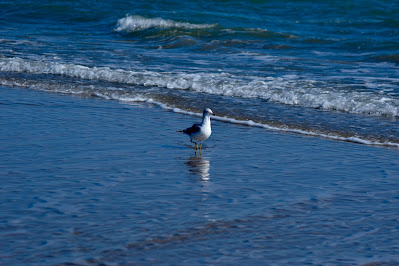Worth it!
Our third long day of driving, broken up by the stay-over in Del Rio, began to try our patience. How many miles of thorny chaparral on dry tabletop ground can there be, after all! As we drove and drove and drove along mostly narrow pavement, we began to grouse just a bit. The good news is that we got lost only once and even that did not require backtracking, only finding a different way to get where we intended.
We were pleased when we were followed into a gas station ($2.73 out there) by a local who was curious about our rig. He wanted something similar and was curious about the Tacoma's ability to pull the Wolf Pup. We gave him a brief tour and continued on our way. Too bad we don't get a commission.
It was the unexpected big cities - Laredo & McAllen - that gave us grief with traffic and then the many small towns that required slowing. To pass the time, I looked up information about some of the places. We were astounded to learn that Laredo (which seemed endless, and with no cowboys ambling down the streets) is the largest inland port in the United States. More than 47 percent of United States international trade headed for
Mexico and more than 36 percent of Mexican international trade crosses
through the Laredo port of entry. Sadly in my ignorance, I had no idea it was even a port, much less such an important one.
Also, it is the least ethnically diverse city in the U.S. with 95% Hispanic population.
During the "light at the end of the tunnel" part of the drive, we were dismayed to encounter the city of McAllen with its heavy traffic and road construction. Again the good news: we were just ahead of the worst of rush hour.
We pulled into our RV park at Port Isabel to be greeted by Javier, perhaps the nicest guy ever, and to be directed to our waterfront spot just as he had promised. That's our view in the next photo, an inlet from Laguna Madre, the bay that borders South Padre Island. What a change after so much West Texas desert!
Awed by the allure of being in the vicinity of big water, my instant response when Chris asked what I wanted to do first, was without hesitation: "Beach!" I never get enough of the wonders of the surf and its mysteries.
We walked miles along the beach, over dunes into tidal flats on the island's bay side, always with the reassuring thunder of the surf as our background melody.
As we walked, we worked hard at identifying shore birds: checking details as best we could when they were flying past or scuttling back and forth at water's edge, and comparing them with our guide book, photos, descriptions, habits and territories. And then there are the differences between adults and juveniles, winter and summer plumage, breeding and non-breeding plumage.
Our final candidates for the day to add to the trip list included brown pelican, Forster's tern, laughing gull and sanderling,
. . . even to how sea life uses mankind's discards.
A great discovery . . .
. . . not that it's a big secret or anything, but we were very happy to spend a good bit of time in the South Padre Island Nature and Birding Center! As we have encountered in other southern wetlands, the place utilizes boardwalks to allow entrance through otherwise inaccessible tidal channels.
Even if a person could get through the marshland on foot, there's the small matter of alligators. The Center has become a 'gator refuge, so there are some in pens of a sort, but others are of the free-ranging variety, not a critter one wants to encounter up close and personal.
There are educational components at the SPI Nature Center; however, we gave those a mostly cold shoulder to sashay out for some exciting birdwatching, and even to find a butterfly or two. Yes, flowers are blooming in the region even in January.
It was fascinating to find that the avian life there has become so accustomed to human life skulking above on boardwalks that they pay little mind to what would otherwise be cause for spooking. Not surprising that our trip list grew by leaps and bounds during our time there, and we even picked up some life birds: reddish egret, least grebe and sandwich tern.
Other new trip birds we identified were great egret, great blue heron, tri-colored heron, little blue heron, common gallinule, black-necked stilt, blue-winged teal, roseate spoonbill, redhead, long-billed dowitcher, black skimmer, royal tern, marbled godwit, snowy plover, snowy egret, black-bellied whistling duck, Wilson's phalarope, starling, common yellowthroat, and tropical kingbird.
Our route took us through reed-choked waterways, swampy wetlands and tidal flats. Birding was enhanced by the very low tide providing a variety of environments.
. . . and one individual further inland, preening and grooming atop a tree stump, while surrounded by its minions - black-bellied whistling ducks - and accompanied by a great egret, perhaps better to show off its brilliantly pastel pink plumage.
I was happy to get a shot of a great kiskadee, the one I failed at when we were in Del Rio.
Beyond and oblivious of our fascination with all things avian, we watched surfboarders and parasailers displaying strength and finesse as they enjoyed their sports.
Meanwhile, back at the ranch . . . we tried a spot of angling from the dock with the result of a catch that required some research to identify - a southern puffer - poor ugly creature.






























No comments:
Post a Comment